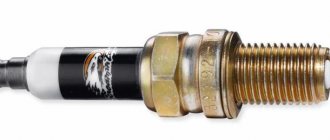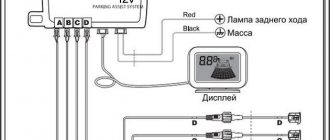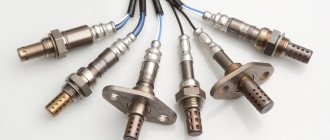July 19, 2020 Lada.Online 1,754 3
Rear suspension with coil springs, double-acting telescopic hydraulic shock absorbers and trailing arms elastically connected by a transverse beam and a stabilizer bar. The following are instructions on how to change the rear shock absorbers and springs on a Lada Granta, Kalina 2 and Priora yourself.
The replacement process is shown on a Lada Granta car. For other models everything is done similarly.
How to lengthen shock absorbers
The role of shock absorbers in the suspension of a car or motorcycle is to smooth out swaying from uneven road surfaces. It may seem that this factor only affects the comfort of using the vehicle, but this is not so. The performance of shock absorbers directly affects the condition of the wheel bearings, tire tread wear, and the length of the braking distance.
Why lengthen the shock absorber?
Manufacturer's engineers do not always have a good idea of the conditions under which the vehicle they create will be operated. The condition of the road surface makes many car owners think about how to improve the cross-country ability and other functional characteristics of their vehicle’s suspension. Sometimes the choice of lengthening the shock absorbers seems quite appropriate.
The length of the shock absorber is set by the vehicle manufacturer. Sometimes you can find reinforced or extended versions on sale, adapted for a specific car model, but more often you have to make changes to the design yourself. First of all, when you decide to modify your car yourself, you should think about the consequences of this event.
Safety precautions
Any changes to the suspension design should only be made if the principles of its operation are well known to you. When carrying out work, you should pay attention to the following circumstances:
* Selecting a suitable room, equipping with the necessary tools.
* If it is necessary to use welding, then it is advisable to involve a professional to carry out the work, or at least carefully check the quality of the weld before installing the shock absorber on the vehicle.
* After completion of work, special attention should be paid to checking the functioning of the suspension.
First you need to carry out several test runs in a safe place at a minimum speed. Only after this can you begin testing the shock absorbers in difficult conditions, braking tests and cornering tests.
Ways to lengthen shock absorbers
There are two different approaches in this matter. The first is to find longer shock absorbers designed for another car model and install them on your car. This is obviously a more expensive method, but also safer - still, control over the production of parts in a factory is higher than in your own garage. The second approach, which is much more popular, is to simply remove the existing shock absorbers and lengthen them.
If the upper part of the shock absorber is a thread, then to extend it you can use a part of the required size of the male-female structure. It screws onto the existing shock absorber and increases it to the required length. When making such a part, it is necessary to select a workpiece that has edges. In this case, it will be easier to tighten and unscrew it using a key.
When the upper end of the shock absorber is crowned with an eye, you will have to use a welding machine. The easiest way is to weld the second eye perpendicular to the first. This limits the final size of the product, but often this modification is sufficient. There is a great temptation to borrow an eye from an old shock absorber that has served its purpose. This should not be done, given its wear and tear and metal fatigue. If there are no other options, then for a while you can be satisfied with such a modification, but it is worth remembering this and, if possible, avoiding dangerous maneuvers that involve the suspension.
In conclusion, it is worth saying that when changing the height of the shock absorber, it is worth taking care of the devices associated with it. It may be necessary to make changes to the design of the spring and bump stop. This will be evidenced by characteristic noises appearing on uneven sections of the road.
motorltd.ru
The influence of spacers on the car suspension. Part 15
The influence of spacers on the car suspension. Part 15
In previous articles, we talked about the effect of spacers on the suspension and the correct increase in ground clearance. We will devote this article to the peculiarities of driving a car with spacers, because not every driver knows how the behavior of his car changes after the correct increase in ground clearance.
How the car's behavior changes
You must clearly understand that installing a full-fledged package for bad roads (long and soft springs, extended shock absorbers and polyurethane spacers) somewhat reduces the car's handling and stability. After all, a soft suspension returns the wheel to the ground more slowly than a hard one. And the longer the wheel is off the ground, the worse the handling. In addition, the soft suspension increases the car's roll in sharp turns, which can lead to skidding or overturning. However, all these changes appear when driving aggressively at speeds above 100 kilometers per hour. If you do not violate traffic rules, then you will not notice any deterioration in the controllability and stability of the car. But the car will become significantly softer, and therefore driving it will be much more pleasant.
If you have not only installed spacers, but also carried out the entire range of work recommended by us, including replacing springs and lengthening shock absorbers, then you can safely drive on normal dirt roads at any speed. The soft suspension will effectively dampen the inertia of the wheel, so the service life of the silent blocks will not change. If you have to drive onto a broken dirt road or real off-road terrain, then when picking up speed, be guided by your own feelings. If driving over bumps does not cause a sensation of impact or swaying, then the speed has been chosen correctly. If the car, driver or passengers jump or sway, it is necessary to reduce the speed. After all, even replacing springs and shock absorbers does not turn a passenger car into a full-fledged SUV.
Driving off-road at high speeds risks damaging your suspension arms. If this happens, you will have to spend a lot of money and time to repair it. If you often drive off-road or on dirt roads, then check the condition of the CV joint boots (constant velocity joints) at least once a week. This will allow you to notice their damage in time and promptly replace the lubricant and boot, which will seriously extend the life of the joint.
Zakolhozil extended the rear shock absorbers — KIA Sorento, 3.3 l., 2007 on DRIVE2
As I found out earlier, the maximum stretch of the rear shock absorbers from the Isuzu Trooper occurred simultaneously with the maximum bending of the stabilizer. However, the suspension definitely still had some range left. Therefore, I have long wanted to study the question of whether it is possible to increase the rear shock absorber without compromising the performance of the suspension. I had some free time, and I started taking measurements. To begin with, I found a place where I could more or less check the suspension travel.
The wheel is not fully suspended, but the shock absorber is already fully stretched (in general the ride was not bad, of course, but I wanted more).
On the other side of the beam, I noticed the remainder of the compression free play. It turned out to be quite decent - about 7 cm. From this I assumed that the shock absorption could be increased by about 5 cm, and the driving performance would not be affected.
Input data: shock absorber rod 10 mm with 1.25 mm thread.
To extend it, I bought 2 couplings from GAZ brakes (length 30 mm, external hexagon for 14 keys) for 45 rubles each and 2 bolts made of solid steel 130mm * 1.25 mm.
Procedure: 1. Using a grinder, I cut off the end of the rod without threads so that the coupling could be screwed on completely.
2. Place 2 M10.3 washers down the rod. We make a tube 31*15 mm (taken from an old Niva shock absorber).4. Place a wide washer 5 mm thick on top.5. Cut a piece of pipe 12*20mm (found in supplies).
6. We grind down the edges of the coupling just above the middle so that the buffer thrust washer fits.
7. Convert the 12 mm hole in the buffer washer into a 14 mm hole.
8. Bend a ring from a thin sheet of metal to center the thick piece of pipe on the coupling.9. We shorten the standard buffer tube from 29 mm to 14 mm.
10. Cut off studs approximately 6 cm long from the purchased bolts and grind one end to a turnkey.
11. We collect all the household items.
the entire extension kit looks like this:
Then I checked it on the same dam - the power reserve of the shock absorber became decent. However, when starting from such a mountain, the wheel slips. This means that the stub still pulls the bridge upward quite strongly. The only thing is that there are doubts about the strength of the coupling. The wall is too thin. If it breaks, I’ll order a turner to turn out a solid part, the dimensions are now clear.
I'll go for now and see. Trial tests are ahead.
Price: 300 ₽ Mileage: 98120 km
Page 2
As I found out earlier, the maximum stretch of the rear shock absorbers from the Isuzu Trooper occurred simultaneously with the maximum bending of the stabilizer. However, the suspension definitely still had some range left. Therefore, I have long wanted to study the question of whether it is possible to increase the rear shock absorber without compromising the performance of the suspension. I had some free time, and I started taking measurements. To begin with, I found a place where I could more or less check the suspension travel.
The wheel is not fully suspended, but the shock absorber is already fully stretched (in general the ride was not bad, of course, but I wanted more).
On the other side of the beam, I noticed the remainder of the compression free play. It turned out to be quite decent - about 7 cm. From this I assumed that the shock absorption could be increased by about 5 cm, and the driving performance would not be affected.
Input data: shock absorber rod 10 mm with 1.25 mm thread.
To extend it, I bought 2 couplings from GAZ brakes (length 30 mm, external hexagon for 14 keys) for 45 rubles each and 2 bolts made of solid steel 130mm * 1.25 mm.
Procedure: 1. Using a grinder, I cut off the end of the rod without threads so that the coupling could be screwed on completely.
2. Place 2 M10.3 washers down the rod. We make a tube 31*15 mm (taken from an old Niva shock absorber).4. Place a wide washer 5 mm thick on top.5. Cut a piece of pipe 12*20mm (found in supplies).
6. We grind down the edges of the coupling just above the middle so that the buffer thrust washer fits.
7. Convert the 12 mm hole in the buffer washer into a 14 mm hole.
8. Bend a ring from a thin sheet of metal to center the thick piece of pipe on the coupling.9. We shorten the standard buffer tube from 29 mm to 14 mm.
10. Cut off studs approximately 6 cm long from the purchased bolts and grind one end to a turnkey.
11. We collect all the household items.
the entire extension kit looks like this:
Then I checked it on the same dam - the power reserve of the shock absorber became decent. However, when starting from such a mountain, the wheel slips. This means that the stub still pulls the bridge upward quite strongly. The only thing is that there are doubts about the strength of the coupling. The wall is too thin. If it breaks, I’ll order a turner to turn out a solid part, the dimensions are now clear.
I'll go for now and see. Trial tests are ahead.
Price: 300 ₽ Mileage: 98120 km
www.drive2.ru
How to lengthen shock absorbers
The role of shock absorbers in the suspension of a car or motorcycle is to smooth out swaying from uneven road surfaces. It may seem that this factor only affects the comfort of using the vehicle, but this is not so. The performance of shock absorbers directly affects the condition of the wheel bearings, tire tread wear, and the length of the braking distance.
Why lengthen the shock absorber?
Manufacturer's engineers do not always have a good idea of the conditions under which the vehicle they create will be operated. The condition of the road surface makes many car owners think about how to improve the cross-country ability and other functional characteristics of their vehicle’s suspension. Sometimes the choice of lengthening the shock absorbers seems quite appropriate.
The length of the shock absorber is set by the vehicle manufacturer. Sometimes you can find reinforced or extended versions on sale, adapted for a specific car model, but more often you have to make changes to the design yourself. First of all, when you decide to modify your car yourself, you should think about the consequences of this event.
Safety precautions
Any changes to the suspension design should only be made if the principles of its operation are well known to you. When carrying out work, you should pay attention to the following circumstances:
* Selecting a suitable room, equipping with the necessary tools.
* If it is necessary to use welding, then it is advisable to involve a professional to carry out the work, or at least carefully check the quality of the weld before installing the shock absorber on the vehicle.
* After completion of work, special attention should be paid to checking the functioning of the suspension.
First you need to carry out several test runs in a safe place at a minimum speed. Only after this can you begin testing the shock absorbers in difficult conditions, braking tests and cornering tests.
Ways to lengthen shock absorbers
There are two different approaches in this matter. The first is to find longer shock absorbers designed for another car model and install them on your car. This is obviously a more expensive method, but also safer - still, control over the production of parts in a factory is higher than in your own garage. The second approach, which is much more popular, is to simply remove the existing shock absorbers and lengthen them.
If the upper part of the shock absorber is a thread, then to extend it you can use a part of the required size of the male-female structure. It screws onto the existing shock absorber and increases it to the required length. When making such a part, it is necessary to select a workpiece that has edges. In this case, it will be easier to tighten and unscrew it using a key.
When the upper end of the shock absorber is crowned with an eye, you will have to use a welding machine. The easiest way is to weld the second eye perpendicular to the first. This limits the final size of the product, but often this modification is sufficient. There is a great temptation to borrow an eye from an old shock absorber that has served its purpose. This should not be done, given its wear and tear and metal fatigue. If there are no other options, then for a while you can be satisfied with such a modification, but it is worth remembering this and, if possible, avoiding dangerous maneuvers that involve the suspension.
In conclusion, it is worth saying that when changing the height of the shock absorber, it is worth taking care of the devices associated with it. It may be necessary to make changes to the design of the spring and bump stop. This will be evidenced by characteristic noises appearing on uneven sections of the road.
Since the appearance of the first cars, designers have been faced with the question of finding the optimal way to dampen body vibrations that arise when overcoming bumps. The best solution, still used today, was the integration of special devices into the car suspension - shock absorbers. At the moment, hydraulic telescopic shock absorbers are widespread. Damping of vibrations of the body and wheels occurs in them due to fluid friction that occurs when fluid passes through narrow holes in the piston - valves. Thus, the mechanical vibration energy is converted into thermal energy. Such important indicators as stability, controllability and smoothness of the vehicle depend on the characteristics of shock absorbers. Modern shock absorbers, based on a general operating principle, differ in types and design features.
Shock absorber classification
Twin tube shock absorber
A twin-tube shock absorber consists of coaxial cylinders, one of which is placed inside the other. The rod with the piston moves in the internal cavity - the working chamber. It communicates with the external one, partially filled with air or nitrogen through the bottom valve. The chamber filled with gas is designed to compensate for the volume of liquid when the rod is immersed.
Twin-pipe shock absorber diagram
Advantages:
- simple design and low manufacturing cost;
- short length;
- low internal pressure (if a small amount of oil leaks through the oil seal, performance characteristics are maintained);
- soft damping of suspension shocks;
- better resistance to mechanical damage.
Flaws:
- oil foaming after prolonged operation and, as a result, a decrease in damping efficiency;
- insufficient cooling;
- Installation, storage and transportation of the shock absorber is carried out in only one position - with the rod up.
Both front and rear shock absorbers can have a twin-tube design. But still, in most cases on modern cars, twin-tube shock absorbers are installed on the rear axle.
Monotube shock absorber
Mono-tube shock absorber diagram
Monotube shock absorbers are gas-filled. Their design provides only one cylinder, in the lower part of which there is a chamber filled with gas under a pressure of 2...3 MPa. This chamber is separated from the liquid by a special floating piston and is designed to compensate for the volume of liquid when the shock absorber is compressed. Due to the fact that the gas constantly pressurizes the liquid in the working chamber, during high-frequency operation of the shock absorber, the effect of oil foaming (emulsification) is prevented, and it also becomes possible to install it in any position.
Advantages:
- better damping and stability;
- improved cooling compared to a two-pipe system;
- possibility of installing the shock absorber in any position.
Flaws:
- long shock absorber length;
- low resistance to mechanical stress;
- high manufacturing costs due to the use of higher quality seals and materials for the housing.
Monotube gas-filled shock absorbers are able to withstand severe loads without loss of performance properties. They are mainly used as front shock absorbers.
Adjustable shock absorbers with variable area valve
Adaptive (or adjustable) shock absorbers involve the ability to change damping properties (damping coefficient). The shock absorbers are equipped with an electromagnetic valve, the cross-section of which changes under the influence of an electrical signal. Reducing the cross-section makes it more difficult for fluid to pass through the valve, increasing the stiffness of the shock absorber. Increasing the valve cross-section, on the contrary, makes it softer.
Adaptive shock absorbers with magnetorheological fluid
Scheme of action of magnetorheological fluid
Adjustable shock absorbers of this type are filled with liquid containing metal particles. This oil changes its structure under the influence of a magnetic field, which is created using coils built into the shock absorber piston. Thanks to magnetorheological fluid, magnetic shock absorbers change their stiffness characteristics in a fraction of a second. The advantage of adaptive shock absorbers is the ability to change the characteristics of the suspension in accordance with current driving conditions: a stiffer suspension will improve the handling and stability of the car, while a softer one will increase ride comfort. The main disadvantage of an adaptive shock absorber is the high cost of its manufacture.
Sports shock absorbers
Sports shock absorbers are designed to operate under extreme loads. They are distinguished by increased rigidity and stability, providing better vehicle handling.
off-road34.ru
How do spacers affect the suspension with different installation methods?
There are several ways to increase ground clearance using spacers. So, similar products can be installed:
- under the springs;
- for shock absorbers;
- under the racks.
Let's take a closer look at the effect of spacers on vehicle performance in each of the above cases.
- Spacers for springs. Many car owners believe that installing spacers on springs reduces the controllability and stability of the vehicle. They are partly right, since increasing the ground clearance due to spacers for springs makes the suspension softer, which increases the car's roll during sharp turns and can lead to skidding or overturning. However, firstly, such a nuisance can only occur with an aggressive driving style and at speeds above 100 km/h. And secondly, if the work on installing spring spacers was carried out in compliance with all the standards and requirements that apply to this process, then you will feel comfortable on roads with any quality of road surface and when driving at any speed.
- Spacers for shock absorbers. When installing spacers on shock absorbers, the stroke of the rods changes, which negatively affects the shock-absorbing properties of this part - as in the case of springs, the suspension becomes softer and does not fully perform its functions. However, if you lengthen the shock absorber by an amount equal to the thickness of the spacer, then the installation of such products will in no way affect the basic characteristics of the car.
- Spacers for racks. Installing spacers on racks can lead to a violation of the rigidity and reliability of the structure, which will affect its shock-absorbing properties and wear resistance. But, as in the above cases, if the work on installing spacers was carried out in compliance with certain standards, then the installation of such products will not in any way affect the driving performance of the vehicle and the wear rates of its components.
You can learn more about how to install spacers in this or that case from this article.
Which is better spacers or reinforced springs: analysis of motorists' opinions
Having analyzed a large number of automobile forums, our company’s specialists, based on feedback from motorists, came to the following conclusion: installing reinforced springs helps to increase the vehicle’s ground clearance without much effort, which significantly increases its cross-country ability. However, among the disadvantages of installing such products, motorists note a significant decrease in the speed characteristics of the vehicle, as well as the lack of a feeling of “sticking” of the car to the road surface at high speeds. As we said above, all these troubles can be avoided if you buy spacers to increase ground clearance and entrust their installation to qualified specialists.
Therefore, the conclusion, in our opinion, is clear - spacers are superior to reinforced springs in their performance properties.
Is it worth installing spacers to increase ground clearance?
In this article, we looked at all the pros and cons of spacers for increasing ground clearance, and also talked about how to eliminate the so-called “disadvantages” that may arise after installing such products. Summarizing all of the above, we can conclude that yes, it is worth installing spacers. However, the installation work must be trusted exclusively to qualified specialists.
We also note that you should not neglect the quality of the products themselves. You can always buy spacers for springs, manufactured in compliance with all the nuances of the technological process. You can view the product catalog from this manufacturer by clicking on the link.
Safe roads and a pleasant trip!
20/07/20











